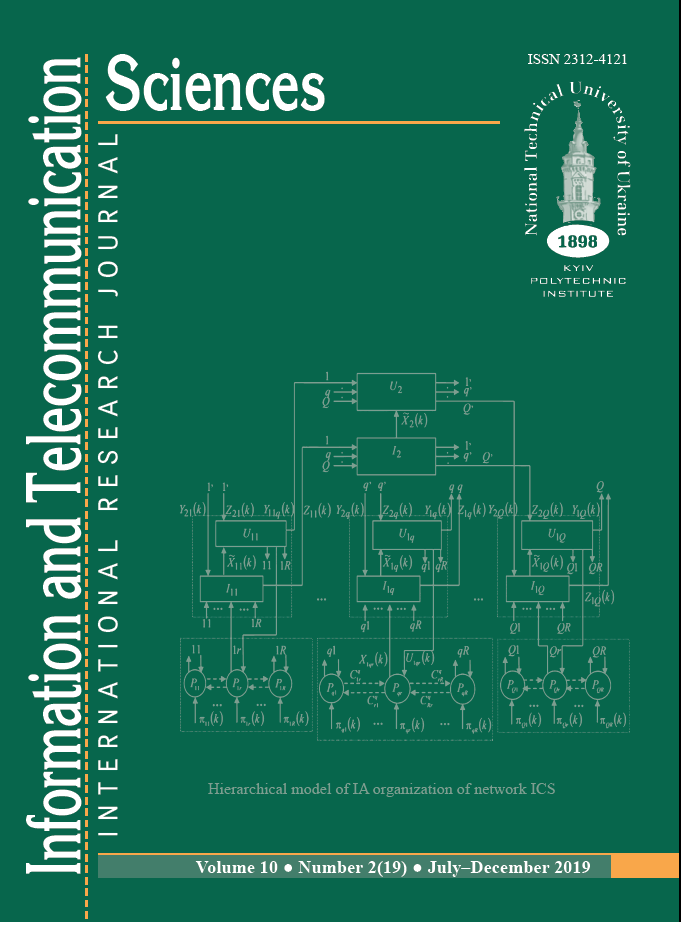MINIMAL PLANNER MOBILE PHONE MIMO ANTENNA WITH ENHANCED GAIN
DOI:
https://doi.org/10.20535/2411-2976.22019.22-28Keywords:
minimal, size, gain, bandwidth.Abstract
Background. Previously, Many MIMO designs were presented for 4G applications. Out of stated 4G MIMO antennas, few designs presented are not suitable for use in mobile phones due to their large size as compared to the standard sizes of current generation mobile phones. The rest, Ceramic based mobile phone antenna and a multi-band MIMO antenna with PIFA structures have significant heights and non-planner structure which makes them unsuitable for mobile phones as they are getting thinner with advancement in technology. Some MIMO antennas were designed with simpler structure and suitable size but they do not have adequate bandwidth. Here there is a need to develop a MIMO system with an adequate bandwidth to cover all 2G, 3G and 4G bands as well as compact to be suitable for mobile communication.
Objective. The purpose of the paper is to design a compact planner MIMO antenna Suitable for Mobile communication with enhanced gain and an enhanced bandwidth to cover all 2G, 3G and 4G bands
Methods.
i. A monopole was designed with proper dimensions, which was designed to operate at focus recurrence of 1.8GHz. That covers the wide scope of data transfer capacity from 1.1 GHz to 2.7 GHz at -9 dB reference line. Then an inverted L shape structure known as SIR stub technique is used to enhance the bandwidth.
ii. The inverted L shape structure which is extended from the ground plane is put around the monopole which generates the low resonant frequencies and also broadens the bandwidth. Bandwidth is broadened to 0.8 GHz to 3.5 GHz.
iii. For the purpose of more impedance matching, a small patch is etched from the ground plane opposite to the feeding and all the parameters are optimized
Results. that lower 0.9GHz radiation pattern is omnidirectional while at higher frequencies it is quasiomnidirectional, a steady gain greater than 2.8dBi over the entire frequency band i.e from .8 GHz to 3.5 GHz, a
very high gain of 6.7 dBi at 0.9 GHz. The compact wide band planar MIMO antenna has over 80% efficiency over most of the working recurrence For handy application ECC value less than 0.5 is adequate for mobile phones. The measured ECC is less than 0.36 over complete operating frequency band, which is all right for mobile phones
Conclusions. The paper presents compact planner two port MIMO antenna with wideband width and high gain. The proposed antenna achieved a wide bandwidth from 0.8GHz to 3.5GHz covering 2G/3G/4G bands and Wi-Fi (2.45GHz). High isolation between antenna elements, lower ECC and high diversity gain makes the design of the compact planner wide band MIMO antenna a suitable possibility for mobile phone applications.
References
M. A. Jensen, 1. W. Wallace, "A review of antennas and propagation for MIMO wireless communications," IEEE Trans. Antennas Propag., vol. 52, no. II, pp. 2810-2824, Nov. 2004.
X. Mao and Q. X. Chu, "Compact Coradiator UWB-MIMO Antenna With Dual Polarization," IEEE Trans. Antennas Propag., vol. 62, no. 9, pp. 4474-4479, Sep. 20 14.
W. C. Zheng, L. Zhang, Q. X. Li, and Y. Leng, "Dual-Band Dual-Polarized Compact Bowtie Antenna Array for AntiInterferenceMIMO WLAN," IEEE Trans. Antennas Propag., vol. 62, no. I, pp.237-246,
Jan. 20 14.
S. C. Fernandez and S. K. Sharma, "Multiband Printed Meandered Loop Antennas With MIMO Implementations for Wireless Routers," IEEE Antennas Wireless Propag. Lett.,vol. 12, pp. 96-99, 20 13.
S. F. Roslan, M. R. Kamarudin, M.Khalily, and M. H. Jamaluddin, "An MIMO Rectangular Dielectric Resonator Antenna for 4G
Applications," IEEE Antennas Wireless Propag. Lett., vol. 13, pp. 32 1-324,2014.
Y. J. Ren, "Ceramic Based Small LTE MIMO Handset Antenna," IEEE Trans. Antennas Propag., vol. 61, no. 2, pp. 934-938,
Feb. 20 13.
H. S. Singh, M. Agarwal, and G. K. Pandey, "A Quad-Band Compact Diversity Antenna for GPS L1/WiFilLTE2500/WiMAXlHIPERLANI Applications," IEEE Antennas Wireless Propag. Lett., vol. 13, pp. 249-252,2014.
M. S. Sharawi, A. B. Numan, M. U. Khan, and D. N. A1oi, "A Dual-Element Dual-Band MIMO Antenna System with Enhanced Isolation for Mobile Terminals," IEEE Antennas Wireless
Propag. Lett., vol. II, pp. 1006-1009,2012.
S. Shoaib, I. Shoaib, N. Shoaib, X. D. Chen, and C. G. Parini, "Design and Performance Study of a Dual-Element Multiband Printed Monopole Antenna Array for MIMO Terminals," IEEE
Antennas Wireless Propag. Lett., vol. 13, pp. 329-332, 20 14.
R. G. Vaughan and J. B. Andersen, "Antenna Diversity in Mobile Communications,"IEEE Trans. Veh. Technol, vol. VT-36, no. 4, pp. 149-172, Nov. 1987.
P. Hallbjorner, "The Significance of Radiation Efficiencies When Using S-Parameters to Calculate the Received Signal Correlation
From Two Antennas," IEEE Antennas Wireless Propag. Lett.,vol. 4, pp. 97-99,2005.
A.A.H. Azremi, 1. Toivanen, T. Laitinen, P. Vainikainen, X. Chen, N. Jamaly, J. Carlsson, P.- S Kildal and S. Pivnenko, "On Diversity Performance of Two-Element Coupling Element
Based Antenna Structure for Mobile Terminal," in Proc.4th. Eur. Con! Antennas Propag., 20 10, pp. 1-5.
Y. Gao, X. D. Chen, Z. N. Ying and C. Parini, "Design and Performance Investigation of a Dual-Element PIFA Array at 2.5 GHz for MIMO Terminal," IEEE Trans. Antennas Propag., vol. 55,no. 12, pp. 3433-3441, Dec. 2007.
Ahmed, Z.; Perwasha, G.; Shahid, S.; Zahra, H.; Saleem, I.; Abbas, S.M.: Ultra wideband antenna with WLAN bandnotch characteristic. 2013 3rd International Conference on Computer,
Control & Communication (IC4), 1-5 (Sept. 2013).
Z Ahmed, FK Lodhi, ZU Islam, F Shamshad, I Rashid, FA Bhatti, “Ultra-Wideband Microstrip Antennas with WLAN Band-Notch Capability” International Journal of Computer and Communication System Engineering (IJCCSE), Vol. 2 (4), 2015, 575-580
Z Ahmed, FK Lodhi, M Idrees, ZU Islam, FB Zarrabi, U Majeed, FA Bhatti, “A uniquelyfed miniaturized ultrawideband antenna with
dual band-rejection characteristics.” Sci.Int.(Lahore),27(6),5015-5019,2015.
Z Ahmed, FK Lodhi, FA Bhatti, “Planar Ultra Wide Band Antennas and Band Rejection Characteristics” LAP LAMBERT Academic Publishing, 2016.

